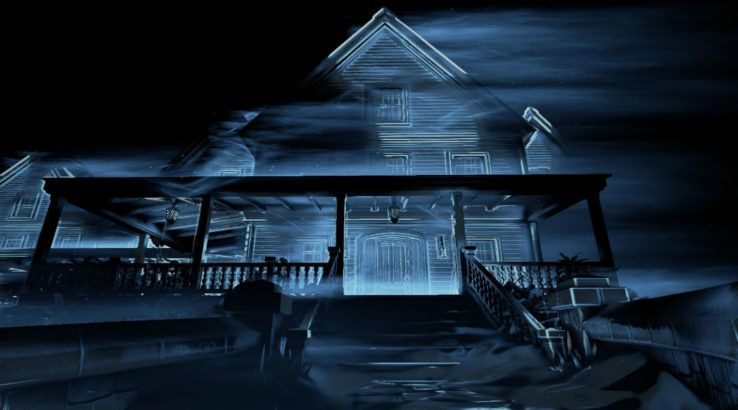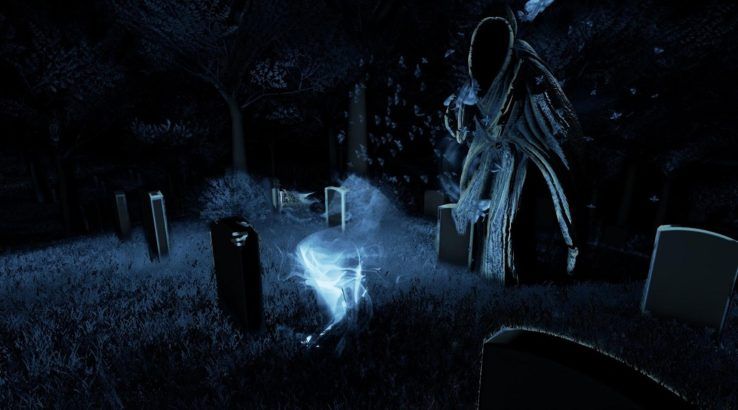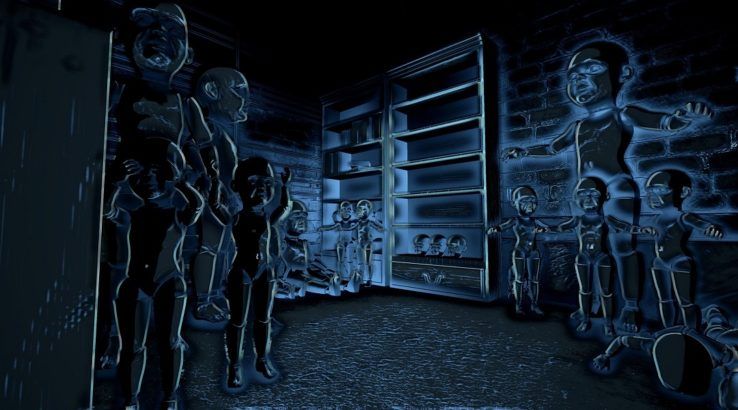It's safe to say that BioShock and Dead Space are two of the most beloved horror games of the last generation, both earning high marks across the board and starting successful franchises. So when it was announced that developers from those two games were banding together to create a new horror game called Perception, expectations were high. Unfortunately, Perception fails to live up to the standard some may have expected, and is simply not a very enjoyable experience.
In Perception, players take the role of Cassie, a blind woman who explores a haunted mansion. This idea in and of itself is fairly unique, as blind protagonists in the video game industry are few and far between. The game is built entirely around Cassie's disability, with most of the game world shrouded in darkness without the use of echolocation.
Cassie's echolocation allows players to "see" the environment around them, which typically consists of three colors: blue, red, and green. The bulk of the environment has a blue outline to it, whereas green denotes important items of interest, and red signals the arrival of a phantom that players have to do their best to avoid. This is an interesting idea and it certainly gives Perception a unique look, but the game can actually be hard on the eyes, especially during extended play sessions.
The annoying art style is compounded by gameplay mechanics that can also grate on one's nerves. To utilize Cassie's echolocation ability, players have to tap her cane, which makes a noise like a tennis ball being thrown into a wall. Players are discouraged from tapping the cane repeatedly, as that is what attracts the phantom, but otherwise they're just stumbling around in the dark.
On one hand, this is a clever way for the developers to try to simulate Cassie's struggles as a blind person. On the other hand, it doesn't make for a fun gameplay experience. Basically, players have to choose between seeing where they are going and listening to the irritating cane tapping sound effect, or they have to walk around aimlessly in hopes that they aren't going to run into any objects or walls.
Of course, players might as well use echolocation as much as they want, as there is no real consequence for being captured by the phantom. If Cassie happens to be caught, she simply respawns at the beginning of the mansion, though no actual progress has been lost. Since there are no stakes, there's no real reason to fear the phantom besides the minor inconvenience that it brings to the table. And in some cases, being caught by the phantom can actually save players from a good deal of backtracking, so it's not always even a bad thing.
Like many modern horror game characters, Cassie can't fight back against any enemies she encounters in the game. When the phantom is near, the area will light up red, and then players quickly have to find a place to hide, usually in things like baskets or closets. If there is nowhere to hide, the only course of action is to walk away from the phantom in hopes that it will disappear before catching Cassie, or just let it grab her and not bother wasting time trying to hide from the creature.
Cassie's inability to die goes a long way in stripping the phantom of its ability to scare the player. It also makes Perception boring, as it boils down to players just going through the paces, walking to one object after another, finding the "memories" scattered throughout the house, and doing so without any real threat of failure. Perception holds players' hands in other ways as well, pointing them directly where to go at the mere press of a button. This is a common feature in many modern games, but in something like Perception, it almost feels like cheating.
The lack of challenge translates to a lack of tension. Not only does the phantom become less intimidating after the first couple of encounters, but also the rest of Perception fails to deliver the scares. The game mostly relies on jump scares, some of which are telegraphed from a mile away, and fail to build a compelling or disturbing atmosphere.
Even so, all of these issues could have been forgiven had Perception's narrative been engaging enough to wade through the muck. Unfortunately, this is not the case. While there are certainly interesting developments along the way, the game doesn't deliver a story that compares to the likes of BioShock.
Having said that, the framing device for the narrative is interesting, and is one of the driving forces that may keep some people playing the game, despite its numerous flaws. Perception's plot is segmented into distinct chapters that each tell their own story, set in a different time period of the house. These stories are fairly engaging, and make it worthwhile for Cassie to seek out files and audio tapes to learn as much as possible about the game world. But while these specific stories have their appeals, the overarching story is still a disappointment and is without satisfying payoff.
Perception's mediocre narrative, annoying art style, and frustrating gameplay mechanics add up to a horror game that most fans should skip. In the meantime, The Deep End Games is a studio comprised of talented people that have worked on some of the most remarkable horror games in the industry, so perhaps its next effort will be worthwhile.
Perception is available now for PC, PS4, and Xbox One, with a Nintendo Switch release planned for later this year. Game Rant was provided an Xbox One code for this review.




